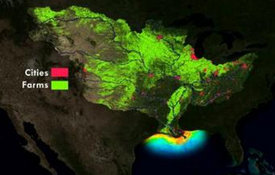http://lenfestocean.org/sites/default/files/pollution_plume_summary_final.pdf
Venayagamoorthy, S.K., H. Ku, O.B. Fringer, A. Chiu, R.L. Naylor and J.R. Koseff. 2011. Numerical modeling of
aquaculture dissolved waste transport in a coastal embayment. Environmental Fluid Mechanics.
A recent scientific study published in the journal Environmental Fluid Mechanics shows that the location of
coastal and offshore aquaculture pens can dramatically influence the extent to which dissolved fish farm
waste disperses from its source and reaches coastlines. This study is the first detailed look at how real
world factors influence the flow of wastewater from fish farms and provides a further basis for understanding
the impact of aquaculture fish-pens on coastal water quality.
Marine aquaculture, or fish farming, is viewed as a means to supplement declining wild fisheries and to
help meet the rising global demand for seafood; however it can cause environmental degradation. For
example, water quality can be significantly impacted because farmed fish excrete much of the nutrients
contained in their feed, including nitrogen and phosphorous. In excess, these nutrients, can trigger
eutrophication and depleted oxygen levels. Nutrients discharges are a particular concern when fish are
grown in open net pens because nutrient-laden feces, undigested feed, and other fish wastes flow freely
into the surrounding environment, some settling to the bottom and other waste products dissolving into
the water column. The concentrations of dissolved waste from net pens are often assumed to decline
continuously in all directions as the discharge moves further from the pens, diluting the environmental
impacts as the distance from the pens increases.
Dr. Venayagamoorthy and colleagues, supported by the Lenfest Ocean Program, explored the influence
of local currents and flow conditions on the concentration and dispersal of dissolved wastes from
marine aquaculture net pens. In order to test the assumption that waste products are consistently
diluted as distance from the net pens increases, the scientists developed an idealized computational
model and performed simulations of dissolved pollutant plumes in variable coastal and offshore marine
environments. The simulations included representations of the local physical environment (i.e., the
shape and depth of the embayment containing the pens), flow conditions (i.e., tides and wind-induced
currents), and the physical locale of the pens relative to the coasts and freshwater discharges.
The scientists showed that specific flow conditions around the aquaculture pens, such as tidal flow, the
earth’s rotation, local river discharges and the drag introduced by the pens, can lead to pockets of
concentrated pollution traveling considerable distances from the source, potentially affecting coastal
waters and the coastlines far from the aquaculture pens themselves.
The results of this study show that producers, regulators and other stakeholders cannot simply assume
that fish waste discharge will be diluted consistently as it moves away from the net pens, or that dilution
is necessarily the solution for aquaculture wastes. Instead, they need to consider how factors such as
tides, river outflows, shape of embayments and other factors will influence the concentration and spread
of dissolved wastewater plumes. Thus, the effluent model created in this exercise can be a useful tool
for predicting a site’s ability to meet water quality standards before aquaculture facilities are built.
Lenfest Ocean Program: Protecting Ocean Life Through Marine Science
The Lenfest Ocean Program supports scientific research aimed at forging
solutions to the challenges facing the global marine environment.
email: info@lenfestocean.org
